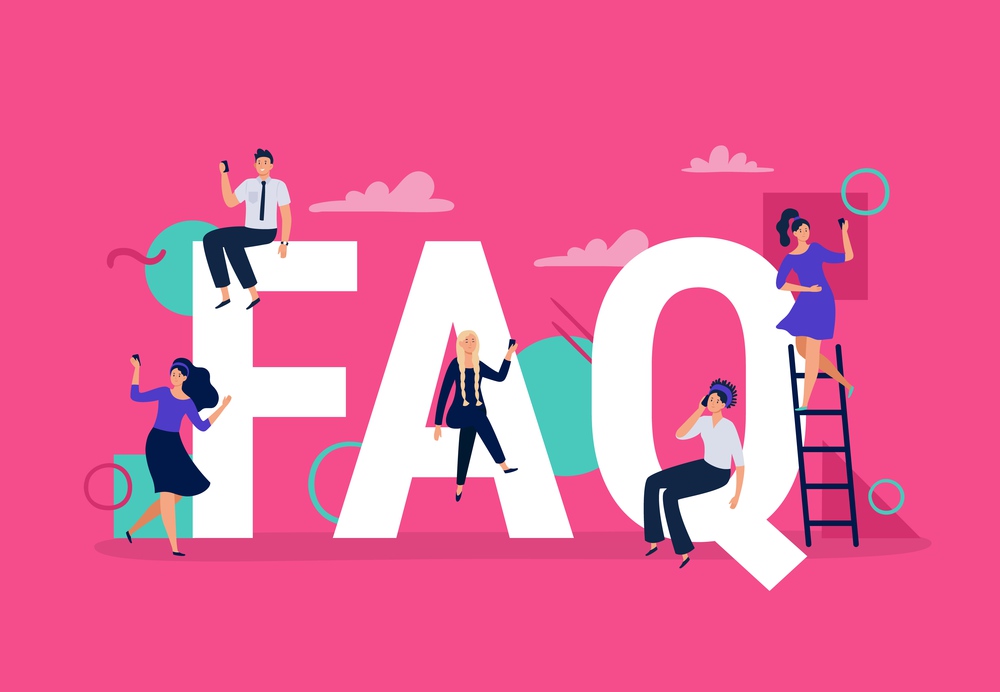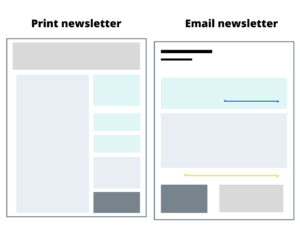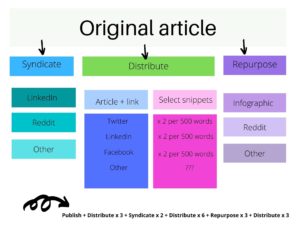Answering prospects’ and customers’ questions on your blog demonstrates your authority, reduces friction on their path to purchase and can improve your content’s chances of appearing in search results. Share your knowledge and expertise in Q&A blogs and other resources that deliver the information people are searching for.
Here’s how.
Gaining traffic and growing authority with informational content that attracts searchers’ interest
Across the internet every day, billions of people enter search queries into their web browsers. Those queries help them locate addresses, gather information, identify new products and services, be entertained, learn new skills, and make decisions.
Many web searches produce zero-click results, or results that present all the information the searcher needs directly on the web browser’s results page.
However, out of the 8.5 billion searches conducted by Google users each day, 45% of searches performed on desktop computers and 43% of those taking place on mobile devices result in an organic click-through to a website.
The businesses that serve the content searchers are hoping to gain traffic for their websites and attention for their brands.
But to earn organic traffic, your content has to be a match for search intent.
Knowing intent is how search engines identify useful results and meeting intent is how you satisfy the people who click-through organic results and land on your website.
What is search intent and why does it matter?
In the digital marketing and search engine optimization industries, search intent refers to the purpose behind a particular search query. Why is someone entering a specific set of words or phrases into the search bar?
Search professionals have identified several broad categories of search intent based on what people want to accomplish when using a search tool. You might think of these categories as identifying the purpose of a search by its job to be done. People enter their search queries in furtherance of some other goal. Identifying that goal helps to understand the searcher’s intent.
Here’s a list of these purpose-related search intent categories from the Semrush blog:
🧭 Informational intent searches represent queries where someone is seeking an answer to a question or wants to learn about a topic. Informational searches may surface results such as a knowledge panel or take the searcher to a website that answers their question.
🧭 Commercial intent searches may also seek information but the searchers ultimate intent is to evaluate or make a purchase. These may include searches for review, recommendation, or “versus” type articles.
🧭 Navigational intent searches occur when a person enters a specific brand, company or domain name or address to reach a specific website. These searches take place when someone hasn’t bookmarked a site they visit frequently, or know a company’s name or product brand but not its URL.
🧭 Transactional intent searches take place when someone is ready to make a purchase. The searcher may enter a general query such as “buy flowers near me” or use the shopping tab to narrow their results.
Did you spot where answering customers’ questions fits in this set?
Yup!
Blog articles that answer people’s questions help them achieve their information-gathering goals. These informational answers may address broad questions about your industry or specific issues related to your products or services.
Identifying a user’s search by one of these main categories is just the beginning of the search intent discovery process. The next step is to understand the context of the individual user’s search. Achieving this understanding is still a work in progress for search engine designers and content makers alike.
Take advantage of search engines’ improved ability to understand search intent with hyper-targeted answers
Search engines like Google Search use their sophisticated algorithms to identify the search intent of a query someone enters in the search bar so that the tool can surface better, more relevant results.
Many search tools already use contextual clues to help them deliver better results for users. For instance, someone searching for seafood restaurants in the US Midwest will see different results than someone performing the same search in a European city. That is, if they have allowed their web browser to collect and gather information about them such as their geo-location.
For hyper-local businesses, their position in the search results may vary depending on where someone is within a city when conducting that search. But that’s a whole other topic.
Some search engines use someone’s browser history to tailor their results while giving their users the option to disable this feature. Still other search tools leverage AI to improve the personalization of their results. Nonetheless, identifying the intent of a specific query isn’t always easy.
That’s why you sometimes get results for a search query that don’t match what you expected.
For example, as the image below illustrates, if I search for the word “content,” using Google search, the results are limited.
An Answer Box at the top of the search results presents a dictionary entry that includes several definitions of the term. A People Also Ask feature and links to additional dictionary websites round out the results.
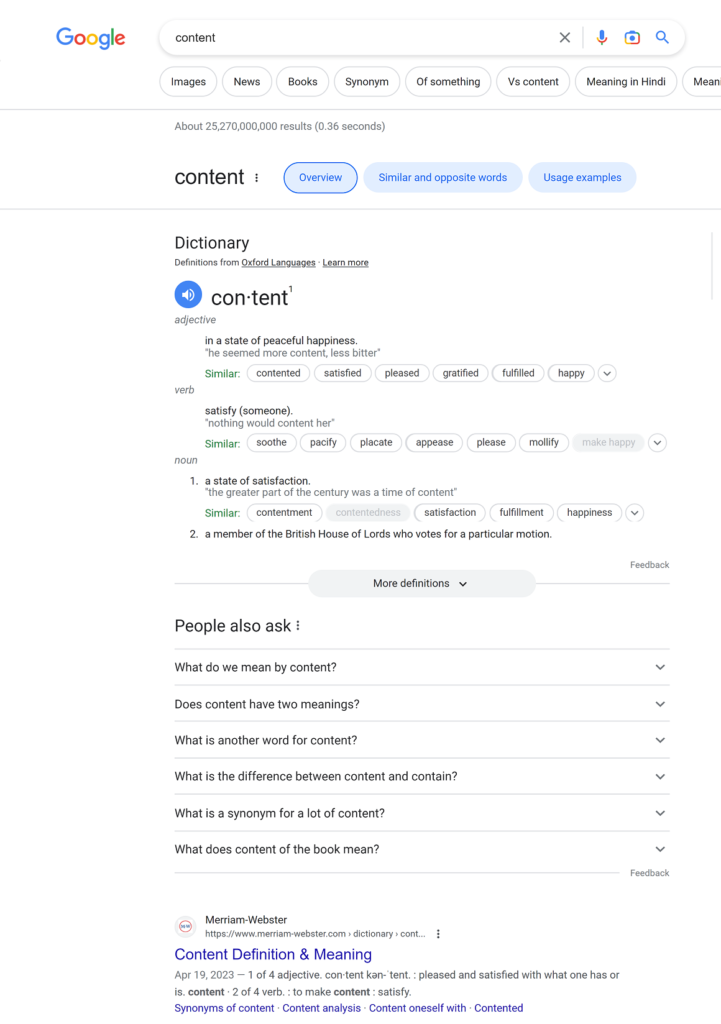
If I want to learn about the emotional state of content or about the types of content produced by creators such as writers or filmmakers, I have to add a few more words to my search query to inform the algorithm about my intent.
If I use content plus the word “marketing,” I’ll see results related to content marketing. The phrase, “How to be content?” will produce personal well-being advice. If I add a food product’s name along with the word content, I’ll get something completely different.
The ability of search engines to understand user intent is improving daily and search providers are experimenting with new ways to deliver better, more personalized results for users. You can learn more about these tools and their implications in the article, Google Launches Project ‘Magi’ to Build AI-Powered Search Engine on the Analytics Vidhya blog.
What this means for publishers is that you have an opportunity to gain high-value traffic by creating articles that target your ideal customer at each stage in your buyer’s journey. Identify the points at which your prospects and customers have questions and the questions they ask, then create articles that satisfy their needs.
Create great answers to win SERP features and raise your business’s profile among searchers
Even if your answers don’t gain website traffic, creating great ones can get your business’s name in front of a wider audience. Appearing in a zero-click result such as an Answer Box, Featured Snippet or “People also ask entry,” increases your business’s name recognition and authority.
What’s the difference between an Answer Box and a Featured Snippet? Both are Google Search features. The main difference is that Answer Boxes report “just the facts” while a Featured Snippet extracts objective and subjective information from the featured content, Ann Smarty explains in SEO: Answer Boxes vs. Featured Snippets, on the Practical Ecommerce blog.
Also, an Answer Box doesn’t always include a link to the source of the information (like in the top result for the “content” query I mentioned earlier.)
Check out the example below, showing the Google Search results for the query, “What is a brand activation agency?”
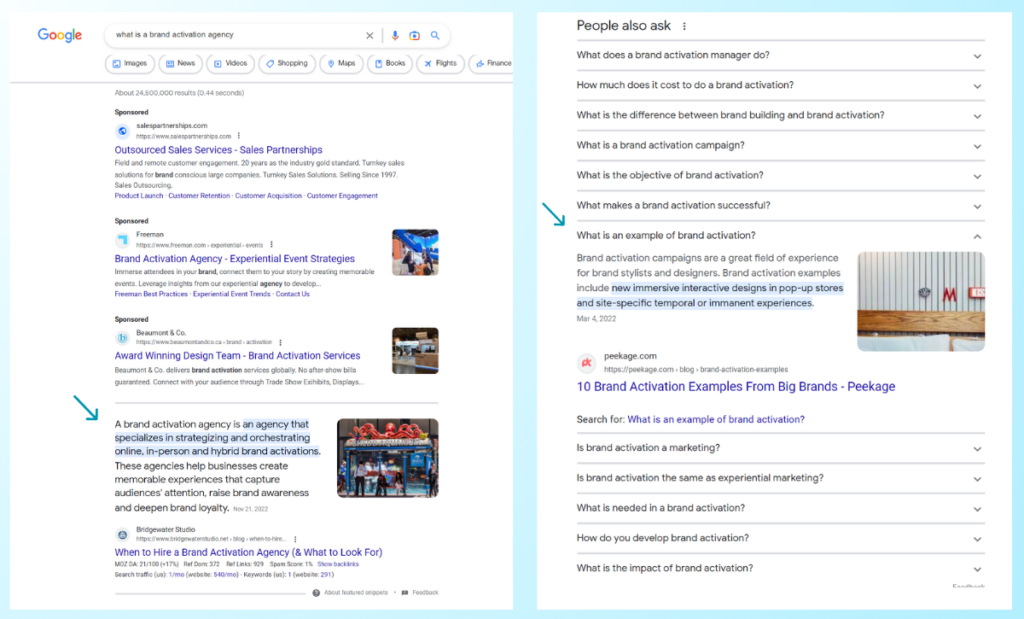
On the first page of the search results, Google presents a Featured Snippet and a People Also Ask feature following the paid or sponsored results.
The Featured Snippet is particularly valuable for building name recognition because the result quotes the linked article and prominently displays the publisher’s logo and name.
The People Also Ask feature also highlights individual publisher’s content similar to how the information is displayed in a Featured Snippet. However, the display isn’t revealed unless a searcher first clicks on the question. So your business might win an “also asked” position, but that doesn’t guarantee that every searcher will see your results.
Use Q&A articles to support and fill gaps in your growth funnel
Adding Q&A content to your company blog improves your search performance, elevates your audiences’ brand experiences, and supports an end-to-end growth marketing strategy by establishing your business’s credibility and nurturing customer relationships.
At the awareness stage of your buyer’s journey, answering the questions your prospects or customers have on their minds (or haven’t thought of yet) is a great way to demonstrate your knowledge, build trust and meet the expectations of modern business and consumer shoppers.
During the discovery stage and activation stages, your informative articles deliver the self-service research resources today’s shoppers want with relevant, discoverable content. Creating answer blogs to anticipate and answer questions is one way for you to deliver.
Finally, during the revenue and advocacy phases, articles that answer frequently asked questions and provide actionable troubleshooting advice gives your customers the self-service support they want.
Can’t purchasers just call customer service or visit your FAQ page? 🤷
Maybe. But to provide complete, prompt post-purchase service to your customers, your business must be present in search.
Today’s shoppers want choice and control before and after they become a customer.
Deliver the self-service resources modern consumers want through answer articles
Generations of digital natives want to find the information they need in the format they want when they want it.
According to customer experience platform NICE, consumers’ top channels for seeking support are chat (52%) and email (47%). One-third of consumers want to find answers on their own via a company’s website, and 81% of consumers want more self-service options..
Despite these figures, 46% of consumers told NICE they always use Google Search first when seeking customer service, and 85% said they start with Google at least half the time.
There are other benefits to delivering on these demands for self-service for your business, too.
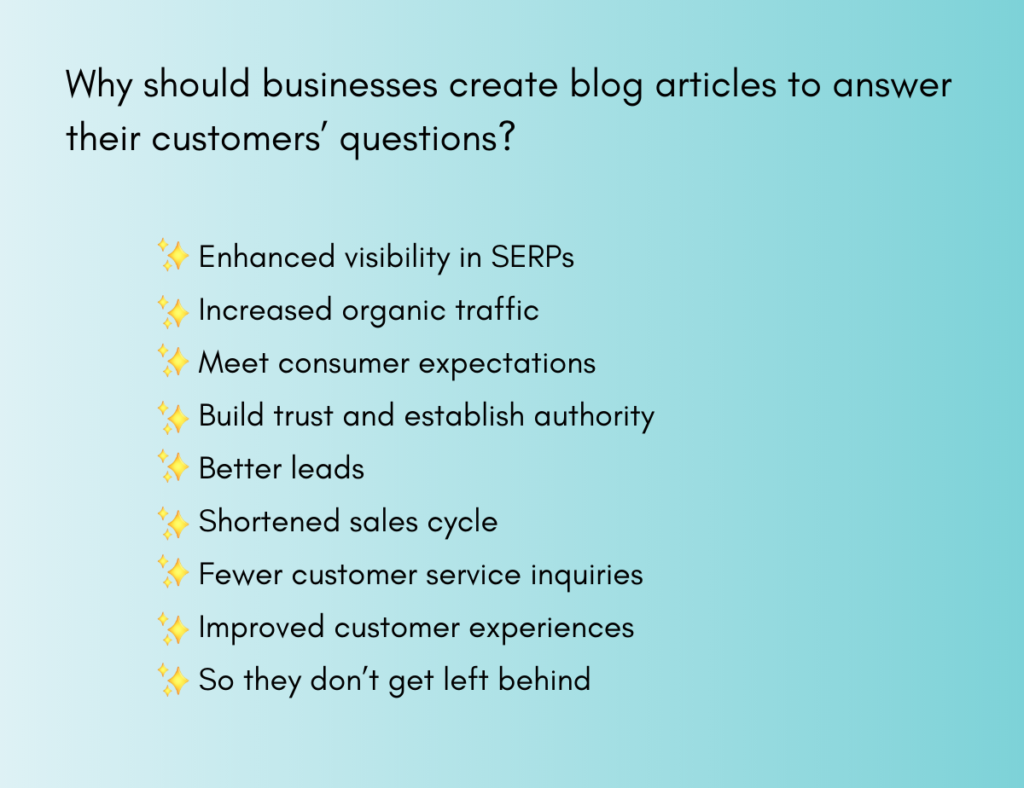
First, your website is a 24/7 storefront, providing answers to questions about your business and its products and services to searchers at their moment of need.
Second, FAQ pages and knowledge hubs can be difficult to navigate. They either contain too much information or not enough. This can leave searchers overwhelmed when trying to find answers or coming up short. An article that answers a single question or related group of questions provides searchers with quick results.
Answer articles enable discovery phase shoppers to self-qualify and speed up the path to purchase with just-in-time answers, too.
Plus, you can reduce the volume of customer service calls and support tickets your team has to manage by writing blog articles to address common onboarding and troubleshooting questions, providing walk-throughs and offering customers links to additional resources.
Finally, developing a robust set of answers to common questions about your business and its products or services positions your brand for the future of search. Search engines, virtual assistants, AI-driven chat bots, voice activated tools and other devices are searching for answers on behalf of businesses and consumers.
Publishing clear, bite-sized answers on your blog makes your solutions easy for these non-human seekers to find and process.
How to decide what questions your business should answer in a blog article
Okay, so I’ve given you lots of reasons you should be answering questions on your blog. Now let me share some ways to pick which questions to answer to maximize the benefits your business gains from this tactic.
1️⃣ Start by making a list of your business and marketing objectives. What are the gaps in your pipeline, the leaks in your funnel, the obstacles in your buyers’ journeys?
2️⃣ Then use your customer profiles and personas, journey maps and historical data to identify the search intent of your highest value prospects and customers.
3️⃣ After you’ve collected a list of relevant questions, prioritize answering the questions that will smooth the path to purchase, reduce churn and increase loyalty.
Where will you find those questions?
Tap into internal and external sources like the following to come up with a list of frequently asked questions, questions no one thought to ask, and questions that have the potential to expand your reach.
Where to find ideas for Q&A blogs inside your organization
The people who communicate with your prospects and customers and the data they collect are a rich source of content ideas for your questions and answers articles. Talk to members of your product, sales, marketing, and customer support teams to find out which inquiries they receive over and over again.
Data mine your customer service logs, texts and emails and other two-way communication channels to uncover the issues that your audience cares about. Don’t forget to review feedback from your in-person events or questions entered in the chat section of your webinars!
Look at your existing knowledge hub or FAQs. The questions these resources answer can be refreshed and regrouped for blog articles. And if your research uncovers questions that aren’t answered in your FAQ, consider giving it an update too!
Where to find ideas for articles to answer customer questions outside your organization
I previously mentioned that a lot of people go to Google to find answers about businesses. They also go on social media, third-party review sites, and visit other digital platforms in search of answers. You can go to these same places to find out what types of questions people are asking.
A few easy sources to find people asking questions related to your business are Google’s People Also Asked feature and the suggestion feature of Google Search and other search tools.
Enter a few industry-related terms or phrases related to your product or service and the buying stage you want to target and view the People Also Asked results.
Sometimes, you can locate questions in an individual result entry, too.
In the image below, the arrows point to Google Search features that reveal frequently asked questions.
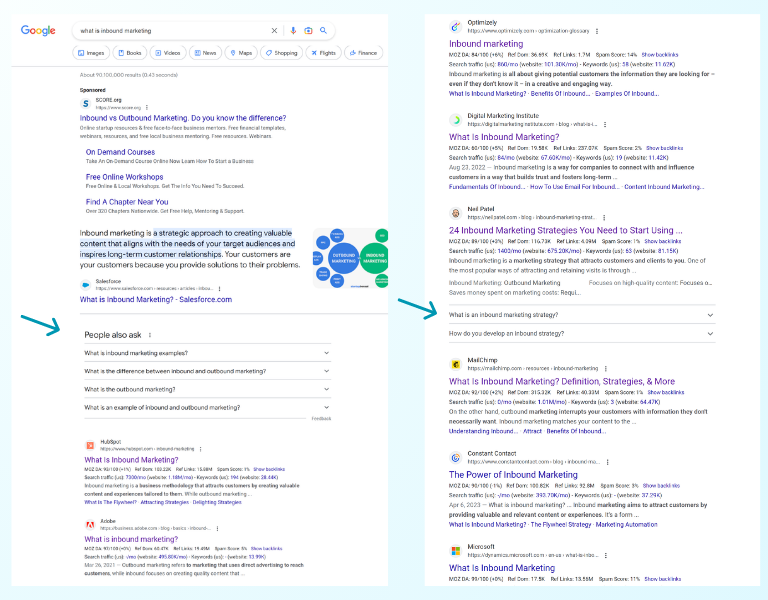
Also, as you’re entering your search phrase in your browser of choice, pay attention to the suggestions your tool makes. (You may need to use a different browser or clear your history to make this latter method work.)
Other tools you can use to see what types of questions people are asking about your targeted subjects include:
- Keywords Everywhere
- Semrush, Ahrefs and other SEO tools
- Answer the Public
- Also Asked
- BuzzSumo
- Yahoo Answers
Third-party websites with structured and unstructured question-and-answer content are also excellent places to find out what’s on people’s minds. Look at related products or services on review and shopping websites such as G2, Capterra, eBay and Amazon.
Or check out the questions and answers displayed on your or competitors’ Google My Business page. (Mine competitors’ webinars and webpage comments for relevant questions, too.)
Seek mentions of your business or competitors on Reddit, Quora, Nextdoor, Alignable and social media sites. Use site specific searches to look for mentions of your products or services, or topics related to your industry to narrow your scope to one site at a time. (e.g., “inbound marketing” site:Reddit.com.)
Keep an eye out for inspiration in trade publications and niche- or industry-specific forums as well.
Two more ways to find questions you can answer on your business’s blog
These last two methods of coming up with content ideas for your answers blogs involve asking more questions.
👀 First, don’t forget that your prospects, customers and clients are the best sources to tell you what’s on their minds.
Ask your favorite customers to share the questions and answers that they found useful when making their buying decisions. Also ask people who haven’t become customers, including the ones that got away, what questions they would have liked to have found answers to.
👀 Second, ask yourself what your prospective buyers and customers learning to use products or services most need to know. What values is it critical that your business communicate to its audience? What are some misconceptions about your business or its offerings that you can correct using your blog? What are some negative truths about your business that you should address head-on?
Want more ideas? Andy Crestodina created an amazing list of 23 questions to inspire your content for the Orbit Media Studios blog.
What else can you do with the answers to customer questions you create for your blog? Repurpose and distribute them!
Once you’ve identified, prioritized and answered your audience’s pressing questions, don’t leave the fruits of your labor to sit idle.
Use these tactics to get the most out of your hard work:
- Create a central data set to store your questions and their answers. Keep this source up to date and accessible to teams across your organization. Use this central knowledge hub as the foundation for all your question-answering content projects.
- Publish your answers on your blog either as single questions and answers or in collections. Accompany these blog answers with explanations, examples, commentary and images to add extra value.
- Select the most asked questions to add to your FAQ page. It’s okay to repeat the same questions and answers in your blog and your FAQs. Keep your FAQs short and to the point. Place internal links in or after each FAQ directing visitors to your relevant blog entries to encourage them to learn more (and spend more time on your website).
- Add relevant questions and answers to specific product or service pages. Make sure your customers can navigate to shipping and return answers easily from your checkout page.
- Use the answers you’ve written to script video guides to accompany your blog answers, appear on product pages or third-party video sites. Use your answer videos on social media and repurpose this content into static images or animated GIFs you can include in your emails.
- Speaking of emails, add answers to FAQs to your welcome and onboarding emails and feature related questions and answers in your email newsletters. Email marketing platform Ongage explains how in the article 40+ Email Newsletter Best Practices and Tips for 2023.
- Create in-app or on-site tool tips and pointers that summarize key answers.
- Use your Q&A content to create social media posts.
- Host Q&A podcast.
- Continue to review, revise and update your questions and answers in response to new research and audience feedback.
Are you ready to answer some questions?
Be a source of information and inspiration for your prospects, customers and clients by anticipating the questions that are on their minds and answering them. Engaging in this exercise will improve your business’s credibility and understanding of your audience.
Need some help to create your knowledge pipeline? Get in touch. I’ll help you find the right questions and prepare engaging, optimized answers for your blog.
